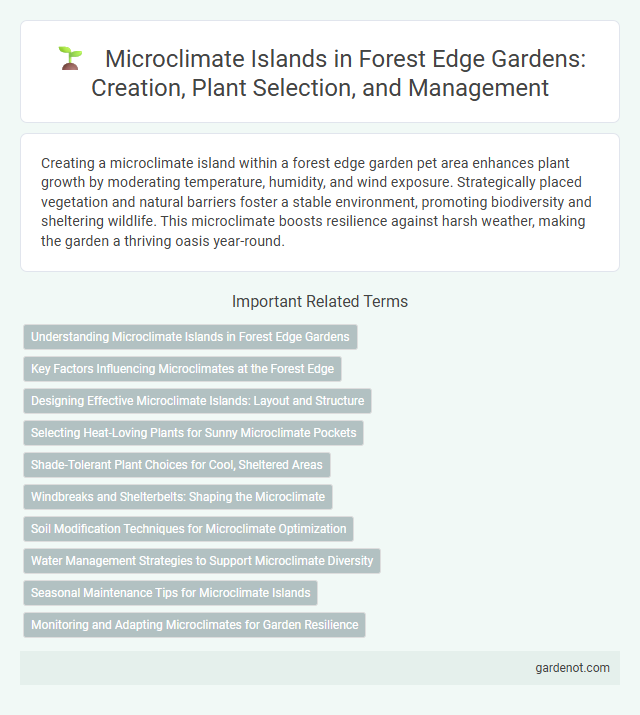Creating a microclimate island within a forest edge garden pet area enhances plant growth by moderating temperature, humidity, and wind exposure. Strategically placed vegetation and natural barriers foster a stable environment, promoting biodiversity and sheltering wildlife. This microclimate boosts resilience against harsh weather, making the garden a thriving oasis year-round.
Understanding Microclimate Islands in Forest Edge Gardens
Microclimate islands in forest edge gardens create unique environmental conditions influenced by the interaction of sunlight, wind patterns, and soil moisture variations. These microclimates foster biodiversity by supporting diverse plant species adapted to specific temperature and humidity levels. Understanding microclimate islands is essential for optimizing plant health, growth, and sustainable garden design in forest edge ecosystems.
Key Factors Influencing Microclimates at the Forest Edge
Microclimates at the forest edge are shaped by factors such as sunlight exposure, wind patterns, and soil moisture levels, creating unique environmental conditions that differ from the forest interior and open fields. Vegetation density and canopy structure play critical roles in modulating temperature fluctuations and humidity, impacting plant growth and biodiversity. Proximity to the forest influences airflow, often resulting in cooler temperatures and increased shade, which support specialized microhabitats along the forest edge garden.
Designing Effective Microclimate Islands: Layout and Structure
Designing effective microclimate islands in a forest edge garden involves creating layered vegetation structures that buffer wind and regulate temperature, enhancing plant growth and biodiversity. Incorporating a mix of evergreen and deciduous species arranged to optimize sun exposure and shade can moderate microclimatic extremes, supporting diverse plant and wildlife communities. Strategic placement of shrubs and ground covers improves soil moisture retention and reduces evaporation, establishing a sustainable and resilient garden microhabitat.
Selecting Heat-Loving Plants for Sunny Microclimate Pockets
Choosing heat-loving plants such as lavender, rosemary, and agave enhances the vitality of sunny microclimate pockets within a forest edge garden. These species thrive in warm, sheltered spots created by natural windbreaks and sun exposure, maximizing growth and flowering potential. Incorporating drought-tolerant and sun-loving plants optimizes water efficiency and creates resilient, vibrant microclimate islands.
Shade-Tolerant Plant Choices for Cool, Sheltered Areas
Shade-tolerant plants like ferns, hostas, and astilbes thrive in the cool, sheltered microclimate of a forest edge garden's island, maintaining lush foliage despite limited sunlight. These species benefit from the moderated temperatures and higher humidity levels created by the surrounding trees and underbrush, promoting healthy growth and resilience. Incorporating such plants enhances biodiversity while ensuring year-round greenery in shaded, protected garden zones.
Windbreaks and Shelterbelts: Shaping the Microclimate
Windbreaks and shelterbelts significantly influence the microclimate of a forest edge garden by reducing wind speed and minimizing soil erosion, creating a more stable environment for plant growth. These natural barriers improve humidity retention and temperature regulation, enhancing the resilience of sensitive species against harsh weather conditions. Strategically planted trees and shrubs within shelterbelts act as protective buffers, promoting biodiversity and supporting healthier garden ecosystems.
Soil Modification Techniques for Microclimate Optimization
Soil modification techniques for microclimate optimization in forest edge gardens involve enhancing soil structure and moisture retention to create favorable conditions for plant growth. Incorporating organic matter such as compost and mulch improves soil fertility and water-holding capacity, buffering temperature fluctuations and reducing evaporation. Raised beds and swales further regulate soil moisture distribution, supporting diverse plant species and promoting a stable microclimate island at the forest edge.
Water Management Strategies to Support Microclimate Diversity
Water management strategies for microclimate islands in forest edge gardens focus on enhancing soil moisture retention through rainwater harvesting and drip irrigation systems. Incorporating permeable surfaces and swales helps direct runoff to plant roots, reducing erosion and promoting biodiversity in varied microclimates. Utilizing native drought-resistant plants further conserves water and supports resilient microclimate diversity.
Seasonal Maintenance Tips for Microclimate Islands
Seasonal maintenance for microclimate islands in forest edge gardens involves monitoring soil moisture levels and adjusting irrigation to prevent water stress during dry periods. Mulching around plants helps regulate soil temperature and retain moisture, reducing weed growth and erosion. Pruning and removing dead or invasive species annually supports plant health and encourages biodiversity within these unique microhabitats.
Monitoring and Adapting Microclimates for Garden Resilience
Monitoring microclimates within a forest edge garden involves tracking temperature, humidity, and soil moisture variations to optimize plant health and growth. Adaptive strategies such as selecting drought-resistant species and implementing shade structures enhance garden resilience against extreme weather fluctuations. Continuous microclimate assessment supports proactive adjustments, promoting long-term ecosystem stability and biodiversity conservation.
Microclimate island Infographic

 gardenot.com
gardenot.com